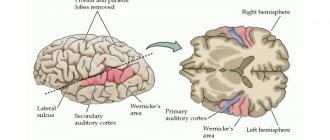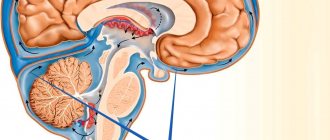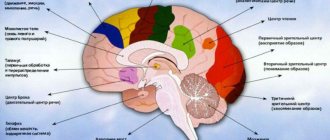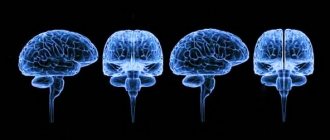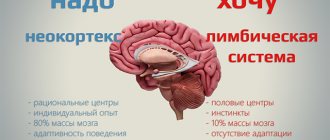Prefrontal cortex
Dorsal lateral prefrontal cortex, external view.
Inferiorbital prefrontal cortex, external view.
Dorsal-lateral prefrontal region (3D surface image, lateral view).
Inferior-orbital prefrontal cortex (internal structure).
Inferior-orbital prefrontal cortex (internal structure). 3D image - bottom surface.
Prefrontal region. Three-dimensional image of the surface, top view.
The prefrontal cortex (PC) is the most developed part of the brain. This area is located in the anterior third of the hemispheres, just behind the frontal bone. Often, three zones are distinguished in the prefrontal region: the dorsolateral (outer surface of the PC), the cortex of the inferior surface of the frontal lobes, and the cingulate gyrus (located in the middle part of the frontal lobes).
We will talk about the cingulate gyrus, which is often considered part of the limbic system, in a separate chapter. The dorsolateral and internal ocular gyri are often referred to as the main control center of the brain. We'll look at both of them in this chapter. If necessary, I will clarify what exactly is known about their functions.
In general, the PC is the part of the brain that monitors, controls, directs, manages and focuses your actions. It is responsible for “executive functions”—the ability to manage time, judgment, impulses, planning, organization, and critical thinking. The ability of humans as a species to think, plan for the future, use time wisely, and communicate with others largely depends on this part of the brain. The PC is responsible for activities that help you stay goal-oriented, socially responsible, and efficient.
Thomas Galtieri, a psychiatrist at North Carolina State, succinctly described the functions of the human PC as “the ability to formulate goals, formulate plans to achieve them, implement them effectively, and change course or improvise in the face of obstacles or failure, and do so successfully in the absence of external guidance.” or structures. The ability of an individual to set goals and achieve them is considered the main characteristic of a mature, effective personality. Moreover, this ability is not determined by social conventions or cultural baggage. This ability is embedded in the structure of the prefrontal cortex and its connections.”2
2 John Ratey, M.D., ed., The Neuropsychiatry of Personality Disorders (Cambridge, Mass.: Blackwell Science, 1995), p. 153.
The prefrontal cortex (especially the inferior frontal cortex) helps us think about what we say or do before we say or do it. Let's say, if you are arguing with your husband (wife) and your PC is working well, most likely you will react thoughtfully, and your answers will be able to correct the situation. If your PC isn't working well, you'll probably say something that will make everyone feel worse. The PC helps you solve problems, calculate how the situation will develop, and, using experience, choose the best one from several options. A good PC function is essential in a game like chess.
This same part of the brain is responsible for how you learn from your mistakes. A good PC performance doesn't mean you don't make mistakes. However, it will help you avoid making the same mistake over and over again. You are able to learn from experience and apply the lessons of the past. Let's say a student with good PC performance is able to learn that by starting work on a large project as early as possible, he will thereby ensure himself more time for research work and will have less reason to worry about not being able to turn it in on time. Meanwhile, a student with reduced PC function does not take past worries and failures into account and will constantly put everything off until the last minute. Those who are unable to learn from past failures tend to have impaired PC function. They constantly make the same mistakes. Their actions are not based on their experience, but on what they want at the moment.
The PC (especially the dorsolateral zone) is also involved in maintaining sustained attention. It helps you focus on important information and filter out less significant thoughts and sensations. Sustained attention plays an important role in short-term memory and learning. Through its many connections to other areas of the brain, the PC allows you to focus on one project for a long time and not be distracted from it until it is completed. The PC sends calming signals to the limbic and sensory systems of the brain when you need to focus, and reduces distracting impulses coming from other areas of the brain. When PC function is reduced, a person becomes more easily distracted from the main activity (we will talk about this in more detail when we begin to discuss attention deficit disorder).
The PC, and especially the dorsolateral area, allows us to experience and express emotions; feel happy, sad, feel joy and love. The way this happens in the PC is different from the more primitive limbic system. Although the limbic system controls mood and sex drive, the PC can translate processes in the limbic system into recognizable feelings, emotions, and words, such as love, passion, or hate. Reduced activity or injury in this area of the brain often results in a decreased ability to express thoughts and feelings.
PC has a major impact on the ability to reflect and control impulsive behavior. The ability to think through the consequences of your actions (choosing a partner, working with clients, dealing with difficult children, spending money, driving on the highway) is critical to living a fulfilling life in almost every aspect of it. Without normal PC operation, it is difficult to act thoughtfully and consistently, and then impulsiveness begins to play a decisive role in our behavior.
The PC has many connections with the limbic system. She sends inhibitory signals that help her keep the limbic system under control. It gives her the opportunity to “think with her head, and not just with her emotions.” When this area of the brain, especially the left side, becomes underactive or damaged, the PC is no longer able to properly influence the limbic system, which can cause an increased susceptibility to depression if the limbic system becomes overactive. . A classic illustration of this would be patients who have suffered a hemorrhage in the left frontal lobe of the brain. Sixty percent of these patients develop severe depression within the first year after a stroke.
Regaining control of the brain
In the picture I have painted, the limbic system and the prefrontal cortex are in constant conflict with each other. And although this is exactly the case when applied to procrastination, the rest of the time these two systems are able to cooperate and produce fantastic results. Because they are responsible for logic and emotion, we owe them some of the most remarkable inventions known to mankind, including language, printing, the light bulb, the wheel, and the Internet. Logical thinking came up with the wheel, but this happened because of the desire to create a more perfect and more convenient world. In addition, the first inventor of the wheel probably became famous among his fellow tribesmen and subsequently enjoyed great success with women. But this is just my personal assumption (absolutely not based on evolutionary psychology).
The interaction of the prefrontal cortex and the limbic system allows us to do things that are enjoyable, interesting and meaningful to us - learning to play the cello, saving for an exotic trip, climbing a mountain, volunteering, creating lasting relationships, achieving long-term results and pursuing our goals. vocation.
Interestingly, although battles between the limbic system and the prefrontal cortex occur in our brains thousands of times a day, we usually do not notice them. Just as 90% of an iceberg is under water, the predominant part of brain activity is hidden in the depths of the subconscious, and only a small part of it appears on the surface, which we are able to track. Productivity programs have such a powerful impact on results precisely because they combine the science of thinking and behavior with a person's conscious intention to achieve more.
The limbic system is essential, but productivity has a lot to do with building a strong prefrontal cortex, which can show the limbic system who's boss when needed and suppress the impulsive urge to check our email or Facebook again, instead directing our attention to things to do. high return. Of course, the limbic system needs to feel good, too, but without a strong prefrontal cortex, it is impossible to realize significant achievements, create strong relationships, and maintain commitment to your value system.
All this is easier said than done. Constant interaction between the prefrontal cortex and the limbic system is a necessary condition for the functioning of the human brain, but it is known that the prefrontal cortex is significantly weaker than the limbic system. The limbic system has evolved over millions of years, while the prefrontal cortex has only existed for thousands of years.
The most productive people are able to not only stop working on autopilot, but also learn to use the prefrontal cortex and minimize the influence of the limbic system.
Stroke in the left frontal lobe
Three-dimensional image of the surface, side view.
3D image, bottom surface.
Notice the large hole in brain activity located in the left frontal lobe.
When scanning the PC with methods such as SPECT, scientists often conduct two studies: one on the brain at rest and another during a concentration exercise. When assessing brain function, it is important for them to see a picture of an active brain. When a normal brain is presented with a task that requires concentration—a math problem or card sorting—PC activity increases. In some brain disorders, such as schizophrenia or attention deficit disorder, PC activity decreases when it is necessary to solve an intellectual problem.
Clinical significance
Behavioral and neuroscientific methods are used to better understand how the human brain thinks, feels, and acts. Diagnosis of brain activity is carried out using instrumental studies. For example, an electroencephalogram (EEG), which records the electrical activity of brain tissue, and functional magnetic resonance imaging (MRI) speaks about the characteristics of brain functions.
Important Psychosomatic causes of arm pain
Neurodegenerative diseases, such as Alzheimer's disease, are markers of gray matter atrophy in the brain. A variety of genetic and chromosomal disorders, some of which are often acquired, can have a negative impact on the cortex. Other neurological disorders such as epilepsy, speech problems (aphasia) are also diseases of the central nervous system.
When the brain is damaged as a result of disease or injury, only one specific lobe may be affected, resulting in impairment of the functions associated with it. The fetus that develops in the womb is very sensitive to various environmental factors. Therefore, toxic effects, for example, the use of alcohol or drugs by a pregnant woman, can cause disruption of the development of the nervous system.
A very rare congenital pathology is lissencephaly, in which the surface of the brain is absolutely smooth, that is, it has no convolutions. This phenomenon is associated with improper migration of neurons at 12–24 weeks of gestation. Children with such a brain are significantly behind their peers in development, most often do not live long and outwardly differ from a healthy child.
Previous
AnatomyThe human lymphatic system, pattern of lymph movement, location of lymph nodes, formation, structure and functions of the lymph node, the meaning of lymph
Next
AnatomyHuman blood vessels main types, structural features, classification, functions and differences of veins, arteries and capillaries, functional groups
Human endocrine glands, structure and functions, where hormones secreted by the endocrine glands are supplied, table with characteristics
